The concept of using a hollow point (HP) to enhance a rifle bullet's
terminal performance came about in the late 1880s and was summarized by John
Barlow in Ideal Handbook #4, published in 1890. Interestingly, the primary
motivation behind the HP design was to reduce the bullet's weight, and hence
increase it's velocity, without changing the bullet's length, thereby allowing
the same rifling pitch to be used. This was the golden age of Express Loads;
lighter bullets driven to the highest velocities attainable with black powder.
These HP bullets were listed as "Express Bullets" in the Ideal Handbook #9
(1897) and were promoted as being able to "increase the killing power of these
rifles by 50%". However, due to the common practice of the day to chamber both
revolvers and lever-guns in the same cartridges for frontier expediency, it
became possible to load and shoot cast HP
ammo in revolvers as well. As a result, cast HP's made their handgun
| |
|
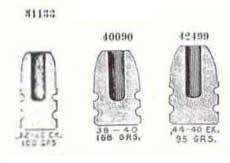 |
|
Figure 1. The first cast hollow point
bullet designs suitable for use in handguns: the Ideal 31133 (for
the .32-20), the Ideal 40090 (for the .38-40) and the Ideal 42499
(for the .44-40). |
|
debut in
sixguns chambered for the .32-20, .38-40 and .44-40 Winchester cartridges
by using bullets cast from the Ideal 31133, 40090 and 42499 moulds
respectively. It is important to recognize that these moulds were all
designed and promoted for use in rifles. However, when cast fairly soft
(typically 20-to-1, lead to tin), these bullets were also found to perform
exceptionally well from revolvers.
Reviewing subsequent Ideal Handbooks, no other HP mould designs
appeared that could be used in handguns until Elmer Keith brought his mould
designs to Ideal. After his SWC designs had proven so successful, he went back
in the early 1930s (1931-2?) and added HP's to his SWC's. The Ideal Handbook #32
(1936) listed the Keith HP designs for the .38 Special and .357 Magnum (Ideal
358439), and the .44 Special (Ideal 429421 HP). These were the first two cast
HP's designed explicitly for use in handguns, and they are two of the finest
hunting bullets ever devised. Keith would later add HP versions of the 454424
(for the .45 Colt) and the 452423 (for the .45 ACP and .45 Auto-Rim). During
roughly the same timeframe (mid-1930s) George Hensley was making moulds (both HP
and otherwise) for Phil Sharpe in his development of the .357 Magnum (Hensley
would later partner up with James Gibbs in 1937). Cramer was also making moulds
for HP handgun bullets in the late 1930s, particularly for the sensational new
.357 Magnum. In the early 1950s, Ray Thompson would add his GC designs to the
list of available Lyman HP mould designs (358156 HP, 429215 HP, 429244HP and
452490 HP). Again, all of these bullets perform their best when cast fairly soft
(typically about 20-to-1 lead to tin for standard velocities, a little harder
for full-thottle magnum stuff).
The binary lead-tin alloys used by Keith, Sharpe and Thompson were
soft, malleable, and not prone to fragmentation. These properties were reflected
in their HP mould designs -- cavities were narrow (ranging from .100" to 170",
typically about .140" in diameter), straight-walled (or only slightly tapered),
and extended halfway (or more) through the length of the bullet. This marriage
of bullet design and alloy is truly exceptional, and expansion of these bullets
with 20-to-1 has to be seen to be believed!
The popularity of casting HP bullets has waned since the 1950s,
although in recent years bullet casting in general appears to be enjoying
something of a comeback. Today, the most common alloy used by the home bullet
caster is wheel-weight alloy. Because this alloy contains a moderate amount of
antimony (about 3-4%), it is somewhat harder, and somewhat more brittle, than
the binary lead-tin alloys used back in the days of Keith, Sharpe and Thompson.
As a result, lower velocity expansion of some of the earlier HP designs can be
hampered by using the harder wheel-weight alloy because of the narrow HP cavity
and the relatively thick walls surrounding it. Higher velocities can lead to
fragmentation and significant weight loss as the HP expands due to the somewhat
more brittle alloy combined with the deep cavities of these HP's. Lyman has
addressed these issues by redefining the basic cast HP concept. Basically, they
made the cavity shallower (limiting possible weight loss during expansion) and
the cavity is now much wider and more conical (making expansion easier when cast
of harder alloy, with thicker walls at the base of the cavity to strengthen the
"mushroom"). In fact, the mouths of these new cavities are as much as a 1/4"
across! They chose to call this new class of HP's the Devastators. But how do
they shoot? And how do they expand?
First let's take a closer look at the Devastator line-up.
Lyman simply took 4 proven bullet designs from their line-up and added
large, conical HP spuds to the mould blocks to create the Devastator line
of HP moulds. The 9mm/.38 Lyman #356637 HP is nominally a 124 grain HP
version of their excellent 147 grain RNFP for the 9mm Parabellum. Their 10mm Devastator (Lyman #401638 HP)
has a listed weight of 155 grains, and is a HP version of their very accurate
175 grain TC design. The .44 Magnum 429640 HP is derived from their outstanding
(but unfortunately no longer available) 429640 GC-FP, and weighs 260 grains as
it drops from the blocks. And the .45 ACP Devastator is derived from the classic
452374 RN and is listed at 180 grains. All four of these HP's have cavernous
cavities in their noses, that range from .215" to over .250" in diameter! As a
result, these mould have a lot of metal in their HP "spuds". In order to cast
high quality HP's with any HP mould, it is important to keep the spud hot (you
will never get good HP's from a cool spud), so it's important to pre-heat the
mould thoroughly, turn the pot temperature up to about 775-800°F, and cast
quickly, to make sure that that fat spud stays up to temperature. Also, it's
important to "sweeten" the WW alloy with about 2% tin to make sure that the
mould fills out properly around the spud. The cavities on all of these bullets
run roughly .300" deep, so the 3 lighter bullets (.565" to .580" in length) are
far more frangible than is the .44 Magnum (.800" in length).
|
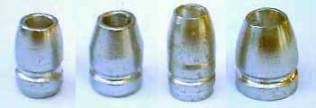 |
|
Figure 2. The Devastator family; the
9mm/.38 356637 HP, the 10mm 401638 HP, the .44 Magnum 429640 HP, and
the .45 ACP 452374 HP. |
|
Since the point of this exercise was to determine the expansion
behavior of these bullets at typical handgun velocities, and not to
systematically evaluate every possible combination to find which loads were most
accurate in my guns, I "cut to the chase" and chose powder charges for each
bullet that have proven their mettle with similar weight cast bullets. All of
these loads gave very satisfying accuracy, but there may well be room for
refinement. Bullets were cast with WW alloy sweetened with 2% added tin, and
lubed with homemade moly lube (equal parts by weight of moly grease and
beeswax). No leading problems were encountered with any of these loads.
Starting with the smallest Devastator, the 356637 HP is the only bevel-based
member of the Devastator family and it fell from the blocks at 127 grains. The
mouth of the cavity mics about .215". It was sized .356" and loaded over 6.5
grains of HS-6, and test fired in a Browning Hi-Power fitted with a Bar-Sto
Match barrel (.356" groove diameter and 1 in 16" twist). Settling on an OAL that
would both feed reliably and chamber cleanly took a little fine-tuning. The
356637 HP has a fair amount of bearing surface that has to be taken into
consideration when deciding on a seating depth, depending on how the throat of
your gun is cut. Just loading them to a favorite OAL will not guarantee that
loaded rounds will chamber, load a dummy round first and make sure that your OAL will both feed and chamber in your gun (I used an OAL of 1.010" and
this fed pretty reliably, but not quite 100%) This load delivered 1257
fps, along with respectable accuracy.
Expansion testing was carried out using 2L plastic bottle filled with
water, laid on their sides and penetrated lengthwise. This light, fragile bullet
fragmented at this velocity and didn't even exit the bottle! Expansion was rapid
and violent. This light fragile bullet is ideally suited for shooting varmints,
and far too fragile for pretty much anything else. Given the "duck-n-dodge" zig-zagging nature of a departing jack rabbit, it seems to me that an accurate, double-stack 9mm (like the Browning Hi-Power), loaded
with these cast HP's is just about perfect for perforating such long-eared prey.
Bring lotsa ammo; expansion won't be a problem, but hitting that sprinting jack
rabbit likely will be...
|
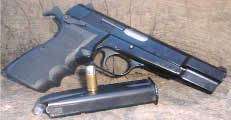 |
|
Figure 3. 356637 HP loaded into the 9mm
Parabellum, and the Browning Hi-Power. |
|
Lyman also promotes this bullet as being a good choice for the .38
Special. Since it drops from the mould at a little over .357", this makes them
essentially unsized when run through a .358" sizer,
and very well suited for revolver work. Loaded into .38 Special brass to a
depth that allows a light roll-crimp to be applied over the ogive (OAL =
1.390"), over a charge of 4.5 grains of Bullseye, this dainty little HP zipped
from the 6" barrel of an old and trusted 5-screw K-38 Masterpiece at 1016 fps
and grouped very nicely indeed. Expansion at this velocity is positive, but not
explosive. This is an excellent load for ground squirrels, prairie dogs and jack
rabbits.
|
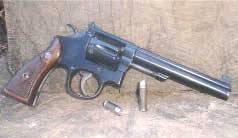 |
|
Figure 4.
356637 HP loaded into the .38 Special, and S&W
K-38 Masterpiece. |
|
Next in line is the 10mm Lyman 401638 HP. My favorite powders for cast
bullets in the 10mm are Accurate Arms #7 and HS-7. The mouth of this HP runs
right at .220". When loaded on top of 11.5 grains of HS-7, this 152 grain cast
HP attained 1304 fps from the new 4" S&W 610. Expansion in either 2L water
bottles or ground squirrels was rapid and explosive. Attempts to recover
expanded bullets from the water bottles resulted only in the recovery of
fragments. This is a flat-shooting load that hits hard and would be well-suited
for coyote and badger-sized critters. I would not expect this bullet to exit on
a broadside ribcage shot on an antelope. Tests of these loads in other barrel
lengths revealed velocities of 1220 fps for 3" and 1374 fps for 6 1/2".
Expansion was consistently explosive in all 3 guns. At the more moderate
velocities of the .40 S&W (ca. 1100 fps), expansion should be positive.
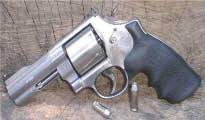 |
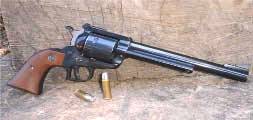 |
|
Figure 5. 401638 HP loaded into 10mm
Auto cartridges, along with a 4" S&W 610. |
|
|
Figure 6.
429640 HP loaded into the .44 Magnum, along
with a Ruger Super Blackhawk, a fine hunting combination. |
|
The big game hunter of the Devastator family is the Lyman 429640 HP
for the .44 Magnum, which has a mouth of .260" and weighs 268 grains checked and
lubed (this is the only member of the Devastator line-up that wears a GC).
Loaded over 22.5 grains of W296 and sparked with a CCI 350 primer, this bullet
delivered 1410 fps from a 7 1/2" Ruger Super Blackhawk with excellent
accuracy (this load runs 1320 fps from a 6"). Expansion testing in
water-filled 2L bottles revealed dramatic expansion. Attempts to recover
expanded bullets were not successful due to over-penetration. This bullet
was used to take a mule deer doe from about 30-35 yards; she never took a
step and was dead before she hit the ground. The 429640 HP expanded well
and exited (neck shot). This bullet seems to provide an excellent
combination of expansion and penetration, making it an excellent hunting
bullet for everything up through deer and black bear sized game.
The Devastator line-up is rounded out by the 452374 HP for the .45 ACP. This plain-based 186 grain HP has a .250" mouth, and believe it or not,
even with this gaping maw up front it feeds just fine in my stock 1911s. When
loaded on top of 7.5 grains of Unique and fired from a full-size Government
Model 1911, this combination generates right at 1100 fps with good
accuracy. Expansion and weight retention at this velocity are superb (see
recovered bullets in Figure 7). In working with this bullet, I was
reminded of the pioneering work developing high velocity hunting loads for
the 1911 by George Nonte, Lee Jurras and others. Recently while
hunting ground squirrels, as a result of these men and their writings, my mind
kept wandering to the deserts of Arizona and the pursuit of javelina whenever I
stuffed these cast HP's into a 1911 magazine. I have to go back to Arizona
again. Soon. This is a good bullet.
|
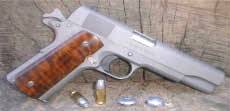 |
|
Figure 7.
452374 HP loaded into the .45 ACP, along with
2 recovered bullets, and a Colt 1911. |
|
I would like to see Lyman extend the Devastator line of HP's
to include HP versions of the Lyman 429649 and Lyman 452651 (both of these
bullets are gas-checked 325 grain RNFPs). Each of these Devastators would weigh
approximately 300 grains, providing the handgun hunter with an excellent
combination of expansion and heavyweight penetration, and would be ideally
suited for hunting elk-sized game. Lyman already has the cherries, and they
already make HP "spuds" in each of these calibers, it's just a matter of putting
the cherry and spud together in the same mould.
The pleasurable pastime of bullet casting allows the
handloader to get that much more out of his shooting hobby by allowing him to
put that much more of his own tastes into it. Typically cast bullets are
associated with non-expanding hard-cast projectiles, producing deep, narrow
wound channels. This is of real value when the handgun hunter takes on large,
dangerous animals that require several feet of penetration to kill efficiently,
but how often does your typical handgunner get a chance to hunt Cape buffalo or guar? For lighter,
thin-skinned game (like deer and antelope), an expanding bullet offers the
handgunner a wider, leakier wound channel, generally resulting in a quicker kill
with these fleet-footed animals. The cast HP is ideally suited for hunting
medium-sized game. In the past, this niche was filled by the Keith and Thompson
HP moulds, but sadly these fine moulds are no longer produced. Lyman has
redesigned the HP concept to accommodate the somewhat harder and more brittle
wheel-weight alloy that is most commonly used to cast bullets today. Lyman's line
of Devastator HP moulds provides bullets that are well-suited to varmint hunting
(9mm), varmints and small/medium game up to about 50-75 lbs (10mm), small/medium
game up to about 150 lbs (.45 ACP), and medium game up to about 300 lbs (.44
Magnum). A one-time investment of a HP bullet mould allows the handloader a
lifetime supply of these fine bullets, and the pride of making his expanding
hunting bullets with his own two hands.
|